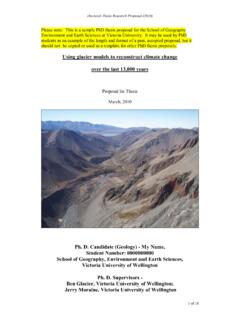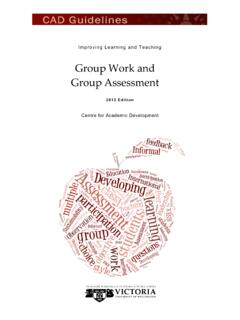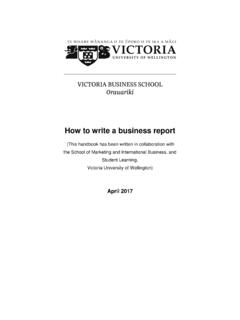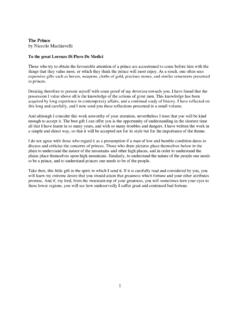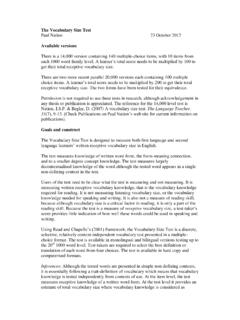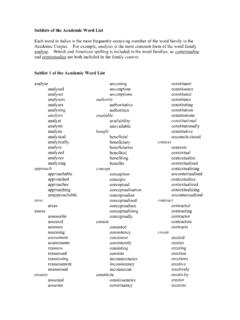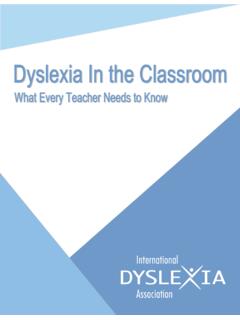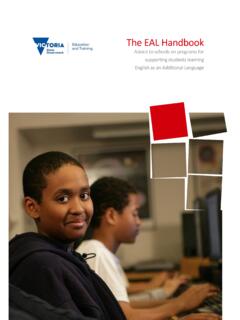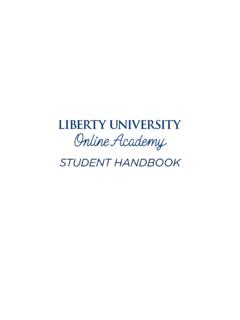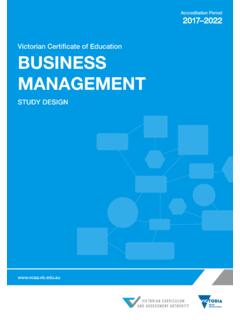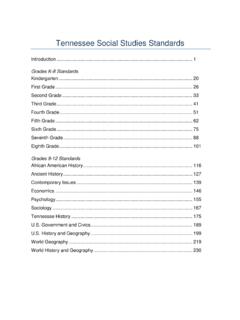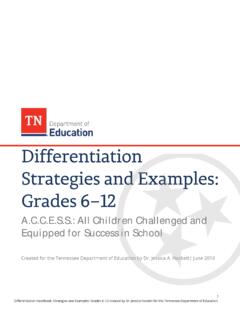Transcription of Writing a Business Report - wgtn.ac.nz
1 How to write a Business Report (This handbook has been written in collaboration with the school of Marketing and International Business , and Student Learning, Victoria University of Wellington) April 2017 i Contents Introduction .. 1 1 Planning your Business Report .. 2 What is the purpose of this Report ? .. 2 Who are the readers of this Report ? .. 2 What are the Report s main messages?.. 3 How will the messages be structured? .. 3 2 Structuring your Business Report .. 4 Covering letter/memorandum .. 4 Title Page .. 5 Executive Summary .. 5 Table of Contents .. 5 Introduction .. 6 Conclusions/recommendations .. 6 Findings and discussion .. 8 References .. 8 Appendices .. 8 3 Writing your Business Report .. 10 Use effective headings and subheadings .. 10 Structure your paragraphs well .. 11 Write clear sentences with plain language .. 12 Keep your Writing professional .. 13 Use white space and well-chosen fonts .. 14 Number your 15 Use footnotes, tables, figures, and appendices appropriately.
2 15 ii 4 Concluding remarks .. 17 References .. 18 Appendix A: Checklist of a Business Report .. 19 Appendix B: Linking ideas within sentences and paragraphs .. 20 Appendix C: Specific Report requirements .. 21 Appendix D: An example of a finished Report .. 23 1 Introduction Writing an effective Business Report is a necessary skill for communicating ideas in the Business environment. Reports usually address a specific issue or problem, and are often commissioned when a decision needs to be made. They present the author s findings in relation to the issue or problem and then recommend a course of action for the organisation to take. The key to a good Report is in-depth analysis. Good writers will show their reader how they have interpreted their findings. The reader will understand the basis on which the conclusions are drawn as well as the rationale for the recommendations. Report Writing uses some of the Writing skills you have already acquired. You will structure your paragraphs and reference your ideas just as you have been doing in your essays and other assignments within your Commerce degree.
3 You might want to refer to the Victoria Business school Writing Skills Workbook you received in the first year. Report Writing sometimes differs in structure and style. This handbook will help you plan, structure, and write a basic Report . Remember, though, that reports will vary according to their purpose and the needs of their reader/s. Throughout your university career, different courses and/or different lecturers may have slightly different requirements for reports. Please always check the requirements for each assignment. Acknowledgement We acknowledge Write Limited, New Zealand s plain English specialists. Many of their principles for good Business Writing are reflected in this handbook . A reference to their style guide is found in the reference list on p 17. 2 1 Planning your Business Report As in all Writing , planning is vitally important. The key questions to ask yourself when planning a Business Report are: what is the purpose of this Report who are the readers of this Report what are the Report s main messages how will the Report be structured?
4 What is the purpose of this Report ? Keep in mind that the purpose of a Business Report is generally to assist in decision making. Be sure you are clear on what decision is to be made and the role the Report plays in this decision. It might be useful to consider the purpose in this way: As a result of this Report , my reader/s will .. For example: As a result of this Report , my reader/s will know: - how well our recycling programme is doing - how to increase participation in it. Who are the readers of this Report ? Consider the main reader/s, but also secondary readers. The main reader for the recycling Report alluded to above is the director of the recycling programme. Secondary readers might be the facilities management team on campus, the finance team, etc. Try to understand what the readers already know, what they need to know, and how they will use this Report . You will need to give enough information to satisfy all these potential readers. You will need to use headings carefully so that different readers can use the Report in different ways.
5 3 What are the Report s main messages? Taking into account the information above, think carefully about the main message/s you need to convey, and therefore what information is required. Ask yourself: What are the required pieces of information I need to include? What are the additional pieces of information I need to include? How will the messages be structured? The modern Business approach is direct (or deductive, to use a more sophisticated term). This approach presents the conclusions or recommendations near the beginning of the Report , and the Report provides justification for these recommendations. This approach will be used for the remainder of this handbook and for Report Writing in general in the Victoria Business school (Commerce Faculty). It should be noted, however, that there is sometimes a place for the indirect (inductive) approach. This approach leads the reader through the discussion first and reveals the conclusions and recommendations at the end of the Report .
6 This approach might be used if the recommendations are likely to be controversial or unpopular (Emerson, 1995). The next step is to construct an outline, or structure, for your Report . Check for a logical flow, and check your outline against your purpose, your reader/s, and the Report s relevant information requirements. 4 2 Structuring your Business Report A Business Report may contain: a covering letter or memorandum a title page an executive summary a table of contents an introduction conclusions recommendations findings and discussion a list of references appendices. Covering letter/memorandum Often a letter is attached to a Report to officially introduce the Report to the recipient. If the recipient is outside the organisation, a letter format is appropriate; if the recipient is inside the organisation, a memorandum/memo is appropriate. The covering letter or memorandum should: remind the reader of their request for the Report state the purpose of the Report acknowledge any assistance indicate future actions to be taken.
7 5 Title Page The title page should be brief but descriptive of the project. It should also include the date of completion/submission of the Report , the author/s, and their association/organisation. Executive Summary The executive summary follows the title page, and should make sense on its own. The executive summary helps the reader quickly grasp the Report s purpose, conclusions, and key recommendations. You may think of this as something the busy executive might read to get a feel for your Report and its final conclusions. The executive summary should be no longer than one page. The executive summary differs from an abstract in that it provides the key recommendations and conclusions, rather than a summary of the document. Table of Contents The table of contents follows the executive summary on a new page. It states the pages for various sections. The reader receives a clear orientation to the Report as the table of contents lists all the headings and sub-headings in the Report .
8 These headings and sub-headings should be descriptive of the content they relate to (see section 3 of this handbook ). 6 Introduction The introduction sets the stage for the reader. It gives the context for the Report and generates the reader s interest. It orients the reader to the purpose of the Report and gives them a clear indication of what they can expect. The introduction should: briefly describe the context identify the general subject matter describe the issue or problem to be reported on state the specific questions the Report answers outline the scope of the Report (extent of investigation) preview the Report structure comment on the limitations of the Report and any assumptions made. (Adapted from Emerson, 1995, p. 35) Conclusions/recommendations A Business Report usually needs both conclusions and recommendations. The difference between conclusions and recommendations in a Report lies in the orientation to time. Conclusions typically relate to the present or past situation.
9 When Writing conclusions: interpret and summarise the findings; say what they mean relate the conclusions to the Report issue/problem limit the conclusions to the data presented; do not introduce new material number the conclusions and present them in parallel form be objective: avoid exaggerating or manipulating the data. (Guffey, Rhodes & Rogin, 2001, p. 391) 7 Recommendations are oriented to the future: what changes are recommended, or what actions are recommended for the future? They are specific, action-oriented suggestions to solve the Report problem. When Writing recommendations: make specific suggestions for actions to solve the Report problem avoid conditional words such as maybe and perhaps present each suggestion separately and begin with a verb number the recommendations describe how the recommendations may be implemented (if you were requested to do this) arrange the recommendations in an announced order, such as most important to least important.
10 (Guffey, et al. 2001, p. 392) Although the conclusions and recommendations are presented before the discussion, they need to logically flow from the discussion. Taking a deductive approach allows the reader insight into your conclusions/recommendations early on. When your reader reads the discussion afterwards, they will follow it more easily. Here are some examples of conclusions and recommendations: Conclusions Recommendations Home and family responsibilities directly affect job attendance and performance. Provide managers with training in working with personal and family matters. Time is the crucial issue to balancing work and family income. Institute a flexitime policy that allows employees to adapt their work schedule to home responsibilities. A manager supportive of family and personal concerns is central to a good work environment. Publish a quarterly employee newsletter devoted to family and child-care issues. (Adapted from Guffey, et al. 2001, p. 391-392) 8 Findings and discussion The discussion is the main part of your Report and should present and discuss your findings.
